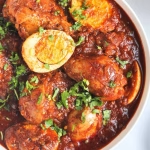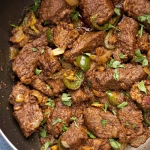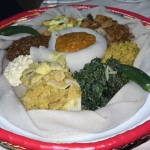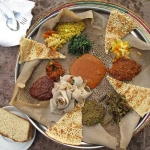
Introduction
Dama Wat With Lablab isn’t just any dish; it’s a hearty Ethiopian stew bursting with flavors that tantalize your taste buds and warm your soul. This traditional recipe features a mix of tender meat and *lablab beans*, creating a combination that’s both nourishing and delicious. Originating from the rich culinary landscape of Ethiopia, Dama Wat is often celebrated for its unique spices and savory sauce, making it a beloved choice for family gatherings and special occasions. In this article, you’ll discover how to make Dama Wat With Lablab at home, explore its delightful ingredients, and learn tips to elevate your cooking experience. So, let’s dive into the world of Dama Wat and embrace its vibrant flavors!
Ingredients
Here’s everything you need to whip up a delightful Dama Wat With Lablab. The ingredients are carefully selected to create a harmonious blend of taste and nutrition. Each ingredient plays a crucial role in defining the dish’s character.
| Ingredient | Measurement | Description |
|---|---|---|
| Chicken (or beef) | 500g | Tender meat enhances the richness of Dama Wat With Lablab. |
| Lablab beans (dried) | 1 cup | Nutty-flavored beans add texture and protein to this hearty stew. |
| Onion | 2 large | Golden onions form the aromatic base of your Dama Wat With Lablab. |
| Garlic | 4 cloves | Fresh garlic enhances the aroma and depth of flavor in Dama Wat With Lablab. |
| Ginger | 1-inch piece | A hint of ginger warms the dish, complementing its spiciness. |
| Berbere spice blend | 2 tbsp | Essential for an authentic taste; this spice mix is the heart of Dama Wat. |
| Salt | to taste | Brings all the flavors together and enhances the overall taste. |
| Vegetable oil | 3 tbsp | Used for sautéing and adds a rich flavor to the stew. |
| Water or chicken broth | 3 cups | For simmering the stew, enhancing the flavors of Dama Wat With Lablab. |
| Fresh cilantro | for garnish | Brightens the dish, adding a fresh touch just before serving. |
Step-by-Step Instructions
Making Dama Wat With Lablab is not only rewarding but also a fun culinary adventure! Follow these steps to ensure your dish turns out perfectly.
- Prepare the Ingredients: Start by soaking the lablab beans in water for a few hours or overnight for better cooking. Chop the onions finely and mince the garlic and ginger. The prep work is crucial for a smooth cooking process and an authentic Dama Wat With Lablab flavor.
- Cook the Base: In a large pot, heat the vegetable oil over medium heat. Add the chopped onions and sauté until they turn golden brown — this step builds the foundation of flavor for your Dama Wat. Stir in the minced garlic and ginger and cook for another minute. The aroma will be irresistible!
- Add the Meat: Introduce your chicken or beef to the pot, stirring occasionally until it’s browned on all sides. This step infuses the meat with the rich flavors from the sautéed base. It’s also the perfect time to sprinkle in the berbere spice blend. Let it cook for about 3-5 minutes to allow the spices to release their fragrances.
- Incorporate Lablab Beans: Now, it’s time to add the soaked and drained lablab beans into the pot. Pour in the water or chicken broth, ensuring everything is submerged. Stir well and bring the mixture to a boil.
- Simmer: Once boiling, reduce the heat to low, cover the pot, and let your Dama Wat simmer for about 60-90 minutes. Stir occasionally and add more water if necessary. The goal is to achieve tender meat and creamy lablab beans.
- Season to Taste: After simmering, taste your stew, and add salt as needed. If desired, you can mix in fresh cilantro for an extra hit of flavor. Serve your Dama Wat With Lablab hot, paired with injera or rice for a fulfilling meal.
Pro Tips
Here are some tips to enhance your Dama Wat With Lablab cooking experience:
- Sauté Slowly: Take your time when sautéing the onions. The more they caramelize, the deeper the flavor of your stew will be.
- Customize Spiciness: Adjust the amount of berbere spice according to your heat preference. You can even add chili peppers for an extra kick!
- Use Fresh Ingredients: Fresh garlic and ginger elevate the flavors tremendously. Don’t skip on those!
Nutritional Information
Here’s a quick look at the nutritional benefits of your homemade Dama Wat With Lablab. Each serving (approximately 1 cup) contains:
| Nutrient | Amount |
|---|---|
| Calories | 350 |
| Protein | 30g |
| Carbohydrates | 45g |
| Saturated Fats | 5g |
| Fiber | 10g |
| Cholesterol | 70mg |
| Sugars | 2g |
| Fat | 12g |
FAQs
- What is the best way to store Dama Wat With Lablab? Store leftovers in an airtight container in the fridge for up to 3 days. Reheat gently before serving.
- Can Dama Wat With Lablab be made vegan or gluten-free? Absolutely! Substitute meat with tofu or more vegetables and ensure you use gluten-free spices.
- What are the best side dishes to serve with Dama Wat With Lablab? Traditionally, Dama Wat is served with injera, but you can also pair it with rice or flatbreads.
- How long does it take to prepare Dama Wat With Lablab? Preparation takes about 30 minutes, and cooking time can range from 60 to 90 minutes.
- Can I freeze Dama Wat With Lablab for later? Yes! It freezes well. Just let it cool completely before transferring it into airtight containers.
- What variations can I make to Dama Wat With Lablab? You can add vegetables like carrots or bell peppers for added nutrition and color.
- How spicy is Dama Wat With Lablab? The spiciness depends on the amount of berbere spice used; feel free to adjust for your taste.
- What is berbere spice made of? Berbere spice is a mix of chili peppers, garlic, ginger, and other spices, giving Dama Wat its distinctive flavor.
Dama Wat With Lablab is more than just a recipe; it’s a celebration of Ethiopian culture and flavors. The tender meat, creamy beans, and aromatic spices come together to create a truly unforgettable dish. Whether you’re a seasoned cook or a beginner, this recipe is accessible and rewarding. So, gather your ingredients, follow the steps, and get ready to impress family and friends with your culinary skills. Tried this Dama Wat With Lablab recipe? Let us know your experience in the comments!






